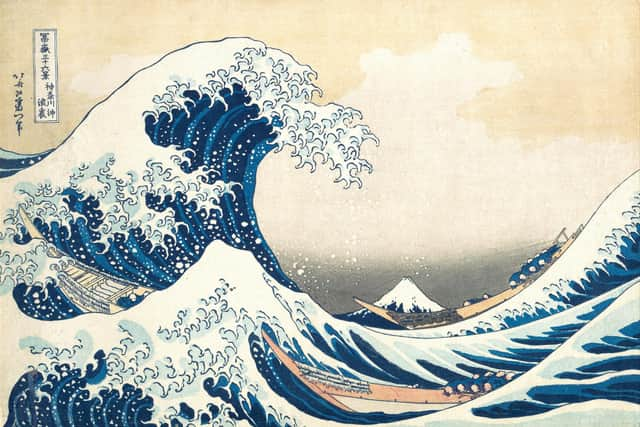Book review: Ocean - Exploring the Marine World, ed. Anne-Marie Melster
Every now and then, somebody somewhere will publish an Everest book. I don’t mean a book about Mount Everest, although there’s not exactly a shortage of those. I’m talking about books for which the brief is so impossibly ambitious that the reasons for even making the attempt are not altogether clear. Just as Mallory, when asked by a reporter why he wanted to climb the world’s highest mountain, replied “because it’s there,” so I imagine the creators of these books must take on the challenge out of a combination of sheer bloody-mindedness and some deep-seated desire to attempt the apparently impossible.
Such must surely be the case with Ocean: Exploring the Marine World, a huge, 2.5kg tome published by art book specialists Phaidon. The book, says the blurb, aims to take readers on “a journey across continents and cultures to discover the endless ways artists and image-makers throughout history – extending over 3,000 years from ancient Greece to today – have been inspired by the world’s oceans." Yup, you read that right: a survey of the entire visual culture of human civilisation as it pertains to oceans. Like I say, bit of a tall order.
Advertisement
Hide AdAs you’d expect for a project of this size, it’s a team effort. There’s no one named author or editor, although curator and critic Anne-Marie Melster is listed as “consultant editor” and has written the introduction. Instead, when selecting the 300-plus images in the book, each one presented with its own mini-essay, the publishers drew on the expertise of a 13-strong advisory panel, which included leading lights from various different fields. On the scientific side, luminaries included Professor Sarah Gille of the Scripps Institute of Oceanography in San Diego; Dr Tammy Horton of the National Oceanography Centre in Southampton and Professor Dr Carsten Lüter, curator of marine invertebrates at the Museum für Naturkunde in Berlin. Art experts included Jon Swanson, curator at Minnesota Marine Art Museum and Sonia Shechet Epstein, curator at the Museum of the Moving Image in New York. On the photography side, we have award-winning wildlife cameraman Doug Allan, acclaimed underwater photographer David Doubilet, and so on. There is also a note at the back thanking "Rosie Pickles for researching and compiling the longlist of entries for inclusion." That must have been an absolutely monumental task, requiring a mind like a steel trap and next-level organisational skills, so at this point Rosie should also stand up and take a bow.


The danger with trying to tackle a topic as vast as this in a mere 300 images, of course, is that certain areas will inevitably feel either underrepresented or conspicuous by their absence. So, as you’d expect, the number of images of ocean-related artwork originating pre-Renaissance is relatively small; ditto the number from non-Western cultures. Also predictable, perhaps: the images of fish and other creatures that spend their lives under the water are legion, whereas the images of the sea birds that feed on them are few and far between. Naval warfare? Doesn’t really feature. Much of the photography is stunning, but would less photographs of colourful sea creatures and more images of sea-inspired paintings, sculptures and ceramics have made for a more interesting read? Perhaps. There’s a lovely photograph of a pod of dolphins, for example, but that’s really all it is. The mini-essay underneath doesn’t tell us much at all about the significance of the image itself, and the observation that dolphins’ propensity to leap out of the water from time to time "makes dolphin watching a popular tourist activity worldwide" is perhaps not adding much to the sum of human knowledge.
On the whole, though, if you’re able to accept that a project with such an impossible brief could never hope to cover all the bases, and simply let the visual feast that’s been assembled wash over you, there’s much to enjoy here. The selected images have been carefully paired across each double-page spread, and they speak to each other in a pleasing variety of different ways. Hokusai’s dramatic woodblock print Under the Wave off Kanagawa, for example – surely a shoe-in for any book such as this – is paired with a contrastingly serene photograph by Japanese photographer Hiroshi Sugimoto, titled North Atlantic Ocean, Cliffs of Moher, 1989. Showing the ocean at its most violent and its most peaceful, the two images hum pleasingly when viewed side by side. There’s a clever symmetry, too, in the pairing of a 1954 movie poster for the Disney’s movie version of Jules Verne’s 20,000 Leagues Under the Sea, complete with ferocious giant squid, with a series of late-16th century German prints depicting whales as monstrous, dragon-like creatures with enormous sharp teeth. As long as the oceans have uncharted depths, these two images seem to say, humans will continue to invent terrifying monsters to inhabit them.
Ocean: Exploring the Marine World, Phaidon, £44.95
